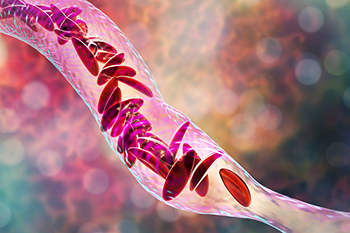Homocysteine levels in the blood is a biomarker that can predict the severity of damage to small blood vessels from sickle cell disease, a study by UC Davis Health physicians and researchers has found.
 Sickle cell disease causes ballooning, changes in diameter and other abnormalities in blood vessels
Sickle cell disease causes ballooning, changes in diameter and other abnormalities in blood vessels
The research is the first to link homocysteine -- an amino acid found in the blood and a risk factor associated with heart disease and stroke -- with complications of sickle cell disease. It also is the first to offer a noninvasive approach to assess vessel damage in patients as young as four years of age. The study was published April 19 in the British Journal of Haematology. It was accompanied by an editorial by specialists at the University of Padova in Italy.
"Adults and children with sickle cell anemia who have high homocysteine levels are likely to have an increased risk of stroke," said Ralph Green, senior author of the study and professor of pathology and laboratory medicine at UC Davis Health. "They also have small vessel disease and white matter lesions in the brain, poor kidney function and low levels of vitamins B6, B12 and folate, which further increase homocysteine levels.
"We conducted our study to evaluate an imaging tool developed in our laboratory to screen for early blood vessel damage, before sickle cell patients experience pain and other symptoms from the damage," he said.
Detecting abnormal blood vessels in sickle cell disease noninvasively
The researchers used a computer-assisted intravital microscope to correlate homocysteine levels in adults and children with damage to small blood vessels in the bulbar conjunctiva, the membrane that covers the outer surface of the eye. They selected the ocular blood vessels because they connect to the internal carotid artery in the neck, offering a potential window into the health of blood vessels in the brain.
The noninvasive screening tool, developed by Anthony T. Cheung, professor emeritus in the Department of Pathology and Laboratory Medicine, enables researchers to assess blood vessel health in real-time. It's an approach physician scientists are also using to evaluate vascular changes in diabetes, high blood pressure, Alzheimer's disease and other chronic disorders.
"We found that homocysteine levels directly correlated with the severity of blood vessel damage to the outer membrane of the eye, regardless of age, gender and levels of B vitamins and creatinine in sickle cell patients," said Green, who is a recognized expert in the diagnosis of hematological disorders, with special emphasis on anemias.
"We think these blood vessel abnormalities develop in early childhood and become more severe with age. The microscope gives us an important noninvasive tool to gauge the health of small blood vessels in sickle cell patients throughout the lifespan," he said. "Early detection of vascular disease is crucial to preventing painful episodes and better managing the disease to reduce the damage to organs from lack of adequate oxygen and blood flow?"
Sickle cell anemia, an inherited condition
Sickle cell anemia is caused by a mutation in the gene that makes hemoglobin, the portion of red blood cells that carries oxygen from the lungs to all parts of the body. The condition mainly affects individuals of African or Middle-Eastern descent.
People with sickle cell anemia have abnormal hemoglobin, which causes red blood cells to become rigid, sticky and misshapen. The irregularly shaped cells affect both large and small blood vessels, slowing or blocking blood flow and oxygen. Episodes of these vascular crises increase in severity and frequency over a lifetime: pain, causing an array of symptoms including bone pain, pulmonary hypertension, retinopathy, stroke and chronic irreversible damage to the brain, heart, lungs, kidneys, eye, long bones and other major organs.
Sickle cell anemia affects millions of people worldwide. According to the Global Burden of Disease Study, 3.2 million people live with sickle cell disease and 43 million have sickle cell trait, a condition whereby an individual inherits only one defective gene and usually does not experience symptoms?
Other co-authors on the study "Homocysteine is associated with severity of microvasculopathy in sickle cell disease" include Sandra L. Samarron Joshua W. Miller, Anthony T. Cheung, Peter C. Chen, Xin Lin, Theodore Zwerdling and Ted Wun.
The research was supported by a grant from the National Heart, Lung, and Blood Institute, National Institutes of Health (R01 HL083276 – Principal Investigator: Ralph Green). Ted Wun is supported by a grant from the National Center for Advancing Translational Sciences (NCATS) (UL100001860).






